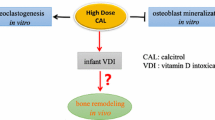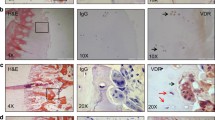Abstract
Target cells for 3H-labeled 1α, 25(OH)2 vitamin D3 [1,25(OH)2D3, vitamin D] and its analog 3H-labeled 22-oxa-1α, 25(OH)2 vitamin D3 (OCT) have been identified during endochondral and intramembranous ossification in developing, undecalcified, unembedded bone, using thaw-mount autoradiography. Two-day-old neonatal rats were injected with [3H]1,25(OH)2D3 or [3H]OCT; after 2 h leg, spine, and head were frozen and sectioned. In the epiphyseal-metaphyseal region specific nuclear concentrations of [3H]1,25(OH)2D3 and [3H]OCT were observed in identical cell populations, being low in cells of the articular and resting zone, intermediate in the proliferating zone, and highest in hypertrophic chondrocytes and in osteoblasts and precursor cells. In the primary spongiosa intertrabecular spaces there were a large number of cells with nuclear labeling — probably osteoblasts and precursor cells. In contrast, in the secondary spongiosa intertrabecular spaces, apparent blood-forming cells were mostly unlabeled. Osteoblasts along bone spicules and compact bone in long bones, vertebrae, and head also showed strong nuclear labeling, as did cells of the periosteum. These data suggest that 1,25(OH)2D3 and OCT regulate development, differentiation, and activities of chondrocytes and osteoblasts, including differentiation of resting chondrocytes into proliferating and hypertrophic chondrocytes that involve “chondroclastic” enlargement of lacunae and “trans-differentiation” of surviving hypertrophic chondrocytes; differentiation of stroma cells into osteoblasts; and in periosteum and other regions of intramembranous ossification differentiation of precursor cells and osteoblasts. Nuclear receptor binding and their selective and hierarchical distribution during cell differentiation appear to correspond to multiple genomic effects toward growth, regeneration and repair. The findings indicate a physiological significance and therapeutic potential of 1,25(OH)2D3 and in particular of its less hypercalcemic analog OCT.
Similar content being viewed by others
References
Beresford JN, Gallagher JA, Poser J, Asked D, Russell RGG (1983) Hormonal and pharmacological regulation of osteocalcin synthesis by human bone cells in vitro. 27th European Symposium on Calcified Tissue. Calcif Tissue Int 35[Suppl]:A26
Böhme K, Conscience-Egli M, Tschan T, Winterhalter KH (1992) Induction of proliferation or hypertrophy of chondrocytes in serum-free culture: the role of insulin-like growth factor-I, insulin, or thyroxine. J Cell Biol 116:1035–1042
Butler WT (1989) The nature and significance of osteopontin. Conn Tissue Res 23:123–136
Cancedda FD, Gentili C, Manduca P, Cancedda R (1992) Hypertrophic chondrocytes undergo further differentiation in culture. J Cell Biol 117:427–435
Crelin ES, Koch WE (1967) An autoradiographic study of chondrocyte transformation into chondroclasts and osteocytes during bone formation in vitro. Anat Rec 158:473–484
Farnum CE, Wilsman NJ (1987) Morphologic stages of the terminal hypertrophic chondrocyte of growth plate cartilage. Anat Rec 219:221–232
Fell HB, Dingle JT (1963) Studies on the mode of action of excess vitamin A. 6. Lysosomal protease and the degradation of cartilage matrix. Biochem J 87:403–408
Fine N, Binderman I, Somjen D, Earon Y, Edelstein S, Weisman Y (1985) Autoadiographic localization of 24R, 25-dihydroxyvitamin D3 in epiphyseal cartilage. Bone 6:99–104
Heersche JNM, Aubin JE (1990) Regulation of cellular activity of bone forming cells. In: Hall B (ed) Bone, vol 1. The osteoblast and osteocyte. Telford Press, Caldwell, N.J. pp 327–349
Holtrop ME (1972) The ultrastructure of the epiphyseal plate. Calcif Tissue Res 9:140–151
Hunziger EB, Herrmann W, Schenk RK, Mueller M, Moor H (1984) Cartilage ultrastructure after high pressure freezing, freeze substitution, and low temperature embedding. I. Chondrocytic ultrastructure-implications for theories of mineralization and vascular invasion. J Cell Biol 98:267–276
Iwamoto M, Sato K, Kakashima K, Shimazu A, Kato Y (1989) Hypertrophy and calcification of rabbit permanent chondrocytes in pelleted cultures: synthesis of alkaline phosphatase and 1,25-dihydroxycholecalciferol receptor. Dev Biol 136:500–507
Kahn AJ, Simmons DJ (1977) Chondrocyte-to-osteocyte transformation in grafts of perichondrium-free epiphyseal cartilage. Clin Orthop Rel Res 129:299–304
Kato Y, Shimazu A, Iwamoto M, Nakashima K, Koike T, Suzuki F, Nishii Y, Sato K (1990) Role of 1,25-dihydroxycholecalciferol in growth-plate cartilage: inhibition of terminal differentiation of chondrocytes in vitro and in vivo. Proc Natl Acad Sci USA 87:6522–6526
Kim YS, Clark SA, Stumpf WE, DeLuca HF (1985) Nuclear uptake of 1,24-dihydroxyvitamin D3 in developing rodent teeth: an autoradiographic study. Anat Rec 212:301–306
Kream BE, Jose M, Yamada S, DeLuca HF (1977) A specific high-affinity binding macromolecule for 1,25-dihydroxyvitamin D3 in fetal bone. Science 197:1068–1088
Manolagas SC, Taylor CM, Anderson DC (1979) Highly specific binding of 1,25-dihydroxycholecalciferol in bone cytosol. J Endocrinol 80:35–39
Narbaitz R, Stumpf WE, Sar M, Huang S, DeLuca HF (1983) Autoradiographic localization of target cells for 1-alpha, 25-hydroxyvitamin D3 in bones from fetal rat. Calcif Tissue Int 35:177–182
Nerlich Ag, Kirsch T, Wiest I, Betz P, von der Mark K (1992) Localization of collagen X in human fetal and juvenile articular cartilage and bone. Histochemistry 98:275–281
Nishii Y, Abe J, Mori T, Brown AJ, Dusso AS, Finch J, Lopez-Hilker S, Morrisey J, Slatopolsky E (1991) The noncalcemic analogue of vitamin D, 22-oxacalcitriol, suppresses parathyroid hormone synthesis and secreiton. In: Berlyne GM, Giovanetti S (eds) Contributions to nephrology. Karger, Basel, pp 123–128
Owen M (1985) Lineage of osteogenic cells and their relationship to the stromal system. In: Peck WA (ed) Bone and mineral research. Elsevier, Amsterdam, pp 1–25
Roach HI (1992) Trans-differentiation of hypertrophic chondrocytes into cells capable of producing a mineralized bone matrix. Bone Min 19:1–20
Sato K, Iwamoto M, Nakashima K, Suzuki F, Kato Y (1990) 1alpha,25-Dihydroxyvitamin D3 stimulates colony formation of chick embryo chondrocytes in soft agar. Exp Cell Res 187:335–338
Sato K, Nishii Y, Woodiel FN, Raisz LG (1993) Effects of two new vitamin D3 derivatives, 22-oxa-1alpha-25-dihydroxyvitamin D3 (OCT) and 2beta-(3-hydroxypropoxy)-1alpha,25-dihydroxyvitamin D3 (ED-71), on bone metabolism in organ culture. Bone 14:47–51
Schenk RK, Spiro D, Wiener J (1967) Cartilage resorption in the tibial epiphyseal plate of growing rats. J Cell Biol 34:275–291
Stumpf WE (1976) Techniques for the autoradiography of diffusible compounds. Methods Cell Biol 13:171–193
Stumpf WE (1988) Vitamin D-soltriol. The heliogenic steroid hormone: somatotrophic activator and modulator. Discoveries from histochemical studies lead to new concepts. Histochemistry 89:209–219
Stumpf WE, Pilgrim C (1994) Artifacts in autoradiography. In: Stumpf WE, Solomon H (eds) Autoradiography and correlative imaging for cells and tissues. Academic Press, San Diego (in press)
Stumpf WE, Privette TH (1991) The steroid hormone of sunlight soltriol (vitamin D) as a seasonal regulator of biological activities and photoperiodic rhythms. J Steroid Biochem Mol Biol 39:283–289
Stumpf WE, Roth LJ (1966) High resolution autoradiography with dry-mounted, freeze-dried, frozen sections: comparative study of six methods using two diffusible compounds, 3H-estradiol and 3H-mesobilirubinogen. J Histochem Cytochem 14:274–287
Stumpf WE, Sar M, Reid FA, Tanaka Y, DeLuca HF (1979) Target cells for 1,25-dihydroxyvitamin D3 in intestinal tract, stomach, kidney, skin, pituitary and parathyroid. Science 206:1188–1190
Stumpf WE, Clark SA, Sar M, DeLuca HF (1984) Topographical and development studies on target sites of 1,25(OH)2 vitamin D3 in skin. Cell Tissue Res 238:489–496
Stumpf WE, Clark SA, Kim YS, DeLuca HF (1985) Comparison of cellular and subcellular distribution of vitamin D metabolites [1,25 (OH)2 vitamin D3, 24,25 (OH)2 vitamin D3, 25 (OH) vitamin D3] in target tissues. In: Norman AW, Schaefer K, Grigoleit HG, Herrath DV (eds). Vitamin D: a biochemical and clinical update. Walter de Gruyter, Berlin, pp 119–120
Suda S, Takahashi N, Shinki T, Horiuchi N, Yamaguchi A, Yoshiki S, Enomoto S, Suda T (1985) 1alpha,25-Dihydroxyvitamin D3 receptors and their action in embryonic chick chondrocytes. Calcif Tissue Int 37:82–90
Takigawa M, Enomoto M, Shirai E, Nishii Y, Suzuki F (1988) Differential effects of 1alpha,25-dihydroxycholecalciferol and 24R,25-dihydroxycholecalciferol on the proliferation and the differentiated phenotype of rabbit costal chondrocytes in culture. Endocrinology 122:831–839
Valaja T, Mahonen A, Pirskanen A, Maenpaa PH (1990) Affinity of 22-oxa-1,25(OH)2D3 for 1,25-dihydroxyvitamin D receptor and its effects on the synthesis of osteocalcin in human osteosarcoma cells. Biochem Biophys Res Commun 169:629–635
Wezeman FH (1976) 25-hydroxyvitamin D3: autoradiographic evidence of sites of action in epiphyseal cartilage and bone. Science 194:1069–1071
Author information
Authors and Affiliations
Additional information
On leave from the University of North Carolina
Rights and permissions
About this article
Cite this article
Stumpf, W.E., Koike, N., Hayakawa, N. et al. 1,25-Dihydroxyvitamin D3 and 22-oxa-1,25-dihydroxyvitamin D3 in vivo nuclear receptor binding in developing bone during endochondral and intramembranous ossification. Histochemistry 102, 183–194 (1994). https://doi.org/10.1007/BF00268895
Accepted:
Issue Date:
DOI: https://doi.org/10.1007/BF00268895




